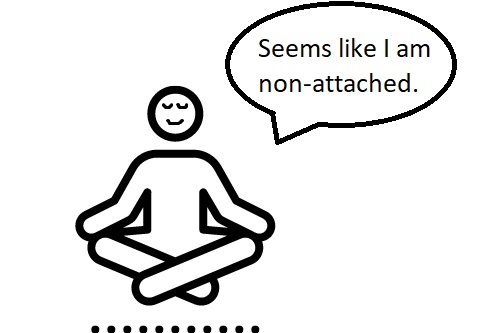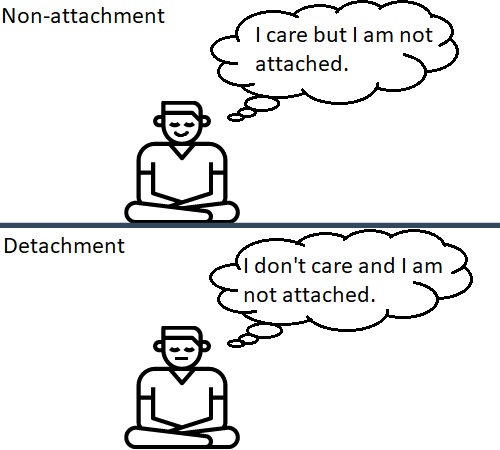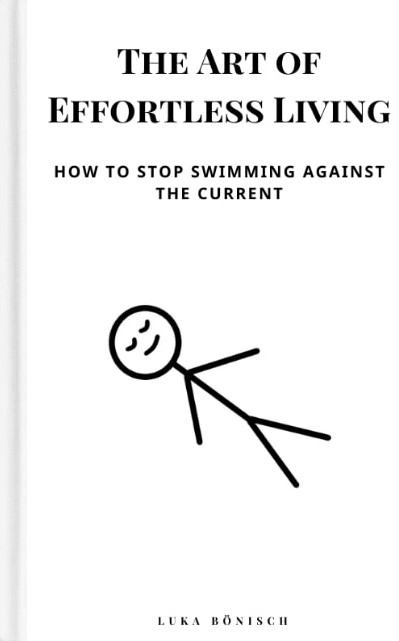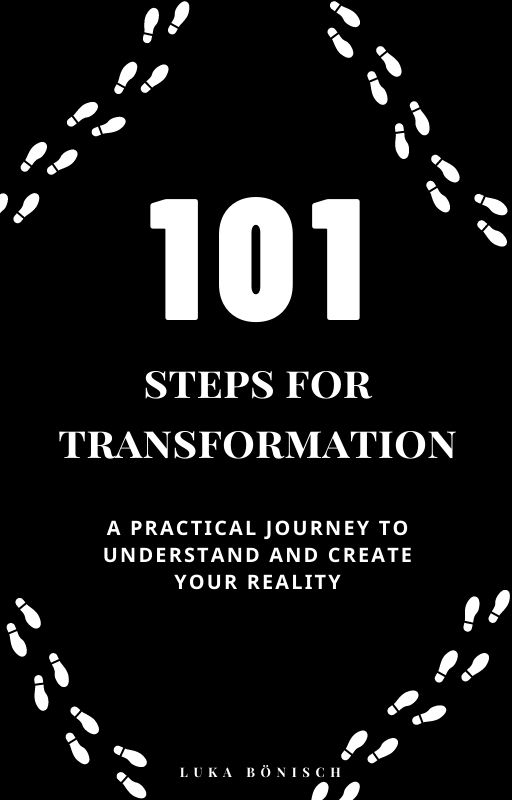Considering all the things we hold so dear in our lives, non-attachment sounds unrealistic, doesn‘t it?
Many of us, however, confuse non-attachment with being emotionally detached, cold, and not caring.
But practicing true non-attachment is quite the opposite. It allows us a life of happiness and freedom because we are not attached to thoughts, things, and people.
Attachment is our constant desire to control the outcome of everything. And this inevitably leads to suffering. The more we try to control our experience of life the more frustrated we’ll get.
Life has its own way of unfolding, often in contrast to our demands on how it should be.
Although this concept is most commonly linked to Buddhism, most other religions and spiritual traditions have incorporated the concept of non-attachment or letting go of desire.
Religion/Spirituality and Non-Attachment

“The root of suffering is attachment.” – The Buddha (Buddhism)
“You have the right to work, but never to the fruit of work. You should never engage in action for the sake of reward, nor should you long for inaction. Perform work in this world, Arjuna, as a man established within himself—without selfish attachments, and alike in success and defeat.” – Bhagavat Gita 2:47-48 (Hinduism)
“Consider the trees which allow the birds to perch and fly away without either inviting them to stay or desiring them never to depart. If your heart can be like this, you will be near to the Way.” – Zen saying
“Act without expectation.” – Lao Tzu (Taoism)
“Giving birth and nourishing, having without possessing, acting with no expectations, leading and not trying to control: this is the supreme virtue.” – Tao Te Ching
“Detachment is not that you should own nothing, but that nothing should own you.” – Ali Ibn Abi Talib (Islam)
“Attach not thyself to anything unless in it thou seest the reality of God – this is the first step into the court of eternity. The earth life lasts but a short time, even its benefits are transitory; that which is temporary does not deserve our heart’s attachment.” – ‘Abdu’l-Bahá, Divine Philosophy, p. 135-136
Aparigraha (or Non-attachment) – (One of the three pillars of Jainism)
As you can see non-attachment plays an important role in many beliefs and traditions.
What is Non-Attachment?

Non-attachment is when we let go of control.
It is about learning to release our thoughts and emotions that create unnecessary suffering.
Non-attachment arises when we are present in the moment. When we are experiencing true non-attachment we surrender and let life unfold naturally on its own terms.
We don’t cling to our thoughts, beliefs, and opinions on how things should be instead we accept things as they are. We co-exist with other people without using them as a means towards an end.
On the deepest level of non-attachment, we let go of everything physical and non-physical so we can be reunited with our Higher Self.
Once we stop being so attached, we will experience an inner sense of peace, calm, and well-being.
Non-Attachment versus Detachment

Although non-attachment and detachment are often used interchangeably, there is a fundamental difference.
When you are detached you are uninvested. When you are non-attached you are invested in the process but not in the outcome.
Detachment indicates withdrawal and negation leading to indifference. You don’t care, and you are emotionally uninvolved.
This is in itself is a fear of attachment. Progressive detachment can lead to a decrease in aliveness and joy of existence.
Non-attachment is different. You do care and you are emotionally involved, but if anything changes, you surrender to the flow of life and let go. Non-attachment leads to more aliveness and joy of existence.
“Nonattachment is simply not holding on, not grasping, whereas detachment implies a distancing from experience, a pulling away, a stance of someone who is being detached.” – Joseph Goldstein
Becoming Attached to Non-Attachment
This sounds comical but this is a common trap we can fall into.
Our ego immediately jumps on the bandwagon and wants to ‘achieve’ non-attachment. But a desire for no desire is still a desire.
Non-attachment is about observing our thoughts and emotions. Ask yourself where you are outsourcing your happiness, to things, events, people. Pay attention to what occupies your mind and drives you.
Be aware that you don’t make non-attachment just a part of your spiritual checklist.
It’s a process to explore our inner processes.
But like everything else non-attachment can easily become a source of attachment. We can’t practice true non-attachment when we are attached to the desire of being non-attached.
How to prevent this from happening we’ll explore soon.
Why Should You Practice Non-Attachment?
Non-attachment is most likely not something that happens all of a sudden. It’s a continuous process of surrender. In some areas this might be easier for you than in others.
You might, for instance, be non-attached regarding your work. So, when you lose your job you just let it go because you know you can easily find another one.
In contrast, you might be very attached to your spouse. You believe that he/she is the One and there will never be someone like that again out there for you.
This can then become the basis for a lot of suffering as there is a constant conscious or subconscious fear of losing him/her.
Non-attachment is liberation from internal and external pressures.
Your life will become much more easy, peaceful, and joyous. In an absolute state of non-attachment worries and fears are non-existent.
You are in a state of abundance because even if you are stripped of everything, you do not see it as a loss. In fact, you realize that there is nothing to be gained or lost.
Here are some more benefits of non-attachment:
• You won’t be controlled by emotions
• You won’t be attached to the outcome
• You’ll be more peaceful and relaxed
• You’ll be more resilient in the face of loss and failure
• You’ll feel more grounded and connected to life
• You’ll experience more freedom
• Your sense of wholeness will increase
• You’ll experience more synchronicities
• You’ll be more loving to yourself and others
• You’ll no longer be seeking external sources of happiness
• You’ll feel more empathy, compassion, gratitude, love, and happiness
How to Practice Non-Attachment
Observe Your Thoughts and Emotions
The first step is to start observing your thoughts and emotions without judging them.
We often want to own our thoughts and emotions and think about them. Instead, watch them flow by like a river. Do not try to hold on to them.
I know “just observe your thoughts without judging them” sounds easier than it might be.
But it’s not about being a perfect observer right away. You are already progressing when you catch yourself identifying with your thoughts and emotions. Then you can gently bring your awareness back to observation.
Also, this doesn’t mean that you are not allowed to be lost in thought ever again.
You can be lost in thought but with practice, you won’t identify with your thoughts. Eventually, it will be like watching a movie or listening to an audiobook.
It helps to remind yourself that you are not your thoughts and emotions.
This is a basic meditative practice and helps you to start shifting your identification from an ego perspective to a transpersonal or soul perspective.
With time you’ll create space between you and your thoughts and emotions. You will no longer be controlled by your thoughts or emotions. Rather you’ll become interested in them.
Stop Seeking Happiness Externally
The belief that something outside ourselves will make us happy is arguable the biggest source of suffering in our world.
As long as you believe that a new, car, house, or relationship will make you happy you are lost in an endless pursuit of happiness.
Instead, turn your attention inward. The more you seek happiness from within (involution) the more you’ll realize that there is nothing to seek.
With practice, you’ll get in touch with your unchangeable core, your essence, your soul.
Regularly give yourself time to sit in quiet and tune into your inner space.
Let go of The Desire to Control Everything
Most of the information we consume and the things we do, we do to gain more control.
Control over ourselves, over our friends and family, over our environment, over nature, over the earth. This behavior stems primarily from fear.
And we think the only way to solve the increasing amount of problems that arise is to gain even more control.
Perhaps a lot of our problems originated from the need to control. Further, maybe a majority of those problems can be solved by letting go of control.
Letting go of control means making friends with uncertainty.
It also means to develop trust that some things can take care of and even should take care of themselves.
When we start to embrace the unknown, fear will give way to curiosity. Instead of dreading uncertainty, we are open to it. We allow life to unfold as it wants and see the unknown as a big, exciting surprise.
Whenever you experience fear of the unknown shift your perspective and see the excitement in it.
Let go of ‘Should’ and ‘Must’
Often we are not aware of how our language influences our perception, beliefs, and behavior.
Observe how you use language in your daily life.
Do you have many expectations of how things ‘should’ be? Or do you believe someone ‘must’ be a certain way?
This is another opportunity to let go of control.
You can’t control other people nor can you control the outcome of things. Let go of the ‘musts’ and ‘shoulds’. That way you can allow life to happen without imposing your expectations on it.
See The Transience in Everything
I challenge you to find something that lasts forever. Everything will sooner or later die.
More so, if you look closely, you’ll see that nothing is ever truly yours, it’s just your turn with it. By internalizing this fact, you can start living life to the fullest.
On one hand, this might make you sad. On the other hand, however, this can help you appreciate life and all its expressions.
Accepting that the only constant in life is change enables us to flow with life.
However, turning inward you might find that part of you that doesn’t change, that is eternal.
“Death is not the opposite of life, but a part of it.” – Haruki Murakami
Exercise for Identifying Attachments
One last thing I want to recommend is to look at all areas of your life.
Write them down and observe what feelings and thoughts come up.
Perhaps you’ll recognize that you identify with some areas more than others. Or maybe you’ll see that you are not attached to a thing or a relationship per se but the feeling or payoff it gives you.
When you come across areas that you feel strongly attached to, ask yourself what you believe the gain is from being attached to it.
It may be comfort, security, love, companionship, or power. Next, ask yourself if you can let go of it and what the consequence of letting go might be.
Often, we think when we let go of something, we will never have that thing or experience again. But exactly this holding on to it is what creates anxiety of losing it and ultimately drives it away.
Final Thoughts
I know, non-attachment seems almost inhuman or unattainable. It requires continuous observation of your thoughts and reflection about your relationship to all things, people, and areas in your life.
I don’t want this to sound like another just-do-this-and-then-you’ll-be-enlightened article. We are still human after all and it is natural to get attached to things. Beliefs, people, things can give us a sense of comfort.
Don’t beat yourself up if you feel attached to something. And don’t pressure yourself into believing you have to be completely non-attached by tomorrow (this again would be an attachment to the desire of being non-attached).
Coming to a place of non-attachment is a process after all. It’s a model to aspire to. Like any model worth aspiring to it takes commitment over time.
So be gentle with yourself and don’t rush into it like it’s a sprint you have to win.
Non-attachment is not something you do it’s a state of being.
Another thing to keep in mind is that non-attachment and letting go are two sides of the same coin. If you want to know more about how to let go and live a life of freedom, I recommend checking out my article on how to let go and free yourself.
So it’s not about being a boring, dull, emotionless shell of a person, but quite the contrary. Non-attachment allows us to live a life full of joy, aliveness, rawness, and simplicity.
△△△
“The thing that is blind is not love but attachment. An attachment is the state of clinging that comes from the false belief that something or someone is necessary for your happiness.” – Anthony De Mello
Luka
Latest posts by Luka (see all)
- The Maelstrom Called You — Why Every Person Is Ecelctic - July 17, 2025
- How to Use Words Correctly - July 8, 2025
- Guilty Until Imagined Innocent - June 25, 2025


